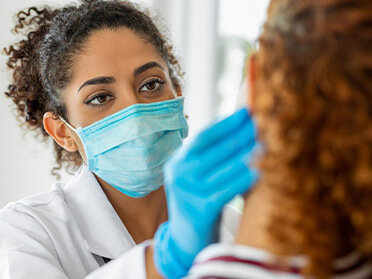Pneumological Diagnostics at UPMC
Pneumological diagnostic tests at UPMC provide examinations of the chest cavity, with the aim of evaluating the presence of any diseases affecting the lungs.
Book an Appointment
At UPMC, we offer pneumological diagnostic services at the following facilities:
Pneumological Diagnostics at UPMC
With UPMC, it is possible to carry out various pneumological diagnostic tests, including:
- Preventive or pre-symptomatic diagnosis.
- Chest endoscopy: This is used to detect pathologies through visualization of the surface of the respiratory branches, also allowing interventional procedures.
- Echo-endoscopic resonance.
- Positron emission tomography (PET).
- Laboratory tests.
- Broncho-reversibility: This is aspirometry test, conducted by bronchodilation, which allows the personalization of therapy.
- Embolization.
- Simple or basal spirometry: This is the measurement of breathing capacity, the amount of air that the lung uses in breathing.
- Global spirometry (nitrogen washout): It measures the amount of air the patient uses during breathing and the amount of total air contained in the lung including residual air after a complete exhalation.
- Diffusion to CO (DLCO): The alveolo-capillary diffusion of CO (carbon monoxide), consists of the execution of a respiratory action designed to measure the speed with which carbon monoxide passes from air to blood.
- Polysomnography: Instrumental recording of neurophysiological and cardiorespiratory signals during a night's sleep.
- Optic bronchoscopy: An investigation based on the use of an optical fiber that is inserted from the nose (or mouth) and pushed along the bronchi to the lung, which allows the operator to conduct a biopsy examination.
- Ultrasound Bronchoscopy (EBUS): It uses miniaturized probes for the study in detail of suspicious lesions of the bronchial wall, such as in the case of small lymph nodes.
- Imaging: Set of techniques with which diagnostic images are obtained relating to organs and systems of the body
- X-rays.
- Computed tomography (CT).
- Magnetic resonance imaging (MRI).
- Pulmonary ultrasound.
- Anatomopathology: Study of organic alterations of tissues and cells, also called pathological anatomy, This process is observable with the naked eye, optical microscope or electron microscope.
- Needle biopsy: Where a sample of lung tissue is needed that cannot be reached with the bronchoscope, a long, thin needle is used that fits between the ribs under radiographic or ultrasound guidance.
- Guided and ultrasound-guided CT biopsy.

Insurance and Conventions
We offer medical services and services on a private basis or in agreement with the main insurance companies. Some of our services are also affiliated with the National Health System.
For more information on active agreements, visit:
